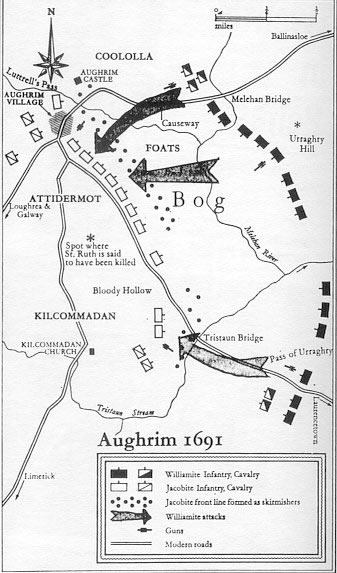The Battle of Aughrim - 1691
The site of this battle was Kilcommadan or Aughrim Hill -
which stretches south-eastward from the ruined castle and
village of Aughrim and which forms the western skyline.
Seen in retrospect, the battle of the Boyne must be regarded
as decisive, but it was not the end of the war. The defeated
Jacobites were still a fighting force and were still to fight
stubbornly before King William could claim victory in Ireland.
The Williamite army moved forward from Athlone on 11th July
1691. The next day there was skirmishing as it came into contact
with the Jacobite outposts.
Froude's
account of the battle
 Sunday,
the I2th July, dawned thick and hazy; a damp fog lay spread
over the marshes, which did not lift until in the afternoon.
At half-past four, with five hours of daylight remaining,
the mist blew off and the English advanced. English properly
they were not. English regiments were intermixed with Danes,
French Huguenots, Scots, Dutch, Brandenburghers, and Anglo-Irish
Protestants, the fitter to try an issue which, however distinguished,
was an episode in the long European struggle for liberty of
conscience. Sunday,
the I2th July, dawned thick and hazy; a damp fog lay spread
over the marshes, which did not lift until in the afternoon.
At half-past four, with five hours of daylight remaining,
the mist blew off and the English advanced. English properly
they were not. English regiments were intermixed with Danes,
French Huguenots, Scots, Dutch, Brandenburghers, and Anglo-Irish
Protestants, the fitter to try an issue which, however distinguished,
was an episode in the long European struggle for liberty of
conscience.
The battle was long doubtful. The ground was trenched in
all directions, and the ditches were lined with Irish sharpshooters,
who stood their ground bravely, and again and again Ginkel's
columns, rushing forward to close with them, were driven back
in confusion. Once St. Ruth believed the day was his own,
he was heard to swear that he would hunt the Saxon into Dublin.
Almost immediately after he was killed by a cannon-ball. The
Hugnenot cavalry, led by Henri de Ruvigny, made a charge,
behind which the English infantry rallied. At last, late in
the evening, the Irish gave way, broke up, and scattered.
Few or no prisoners were taken, and few were reported wounded.
Those who escaped, escaped, those who were overtaken were
made an end of. Seven thousand men were killed before darkness
and rain ended the pursuit. The wreck of the defeated army
divided; part went to Galway, part to Limerick, where the
last act of the drama was to be played out.
(From Froude Vol 1 page 221)
Back to History Home Page
Back to The Williamite
Wars Home Page
|

